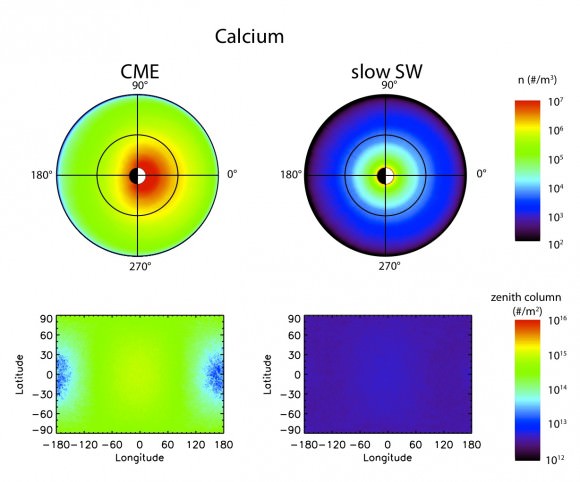[/caption]According to a new set of NASA computer simulations, solar storms and Coronal Mass Ejections (CMEs) can erode the lunar surface. Researchers speculate that not only can these phenomena erode the lunar surface, but could also be a cause of atmospheric loss for planets without a global magnetic field, such as Mars.
A team led by Rosemary Killen at NASA's Goddard Space Flight Center, has written papers exploring different aspects of these phenomena and will appear in an issue of the Journal of Geophysical Research Planets. The team's research was also presented earlier this week during the fall meeting of the American Geophysical Union.
What are CME's? Corona Mass Ejections are intense outbursts of the Sun's usually normal solar wind which consists of electrically charged particles (plasma). CME's blow outward from the surface of the Sun at speeds in excess of 1.6 million kilometers per hour into space and can contain over a billion tons of plasma in a cloud larger than Earth.
Our Moon has the faintest traces of an atmosphere, which is technically referred to as an exosphere. The lack of any significant atmosphere, combined with the lack of a magnetic field, makes the lunar surface vulnerable to the effects of CME's.
William Farrell, DREAM (Dynamic Response of the Environment at the Moon) team lead at NASA Goddard, remarked, "We found that when this massive cloud of plasma strikes the Moon, it acts like a sandblaster and easily removes volatile material from the surface. The model predicts 100 to 200 tons of lunar material – the equivalent of 10 dump truck loads – could be stripped off the lunar surface during the typical 2-day passage of a CME."
While CME's have been extensively studied, Farrell's research is the first of its kind that attempts to predict the effects of a CME on the Moon. "Connecting various models together to mimic conditions during solar storms is a major goal of the DREAM project" added Farrell.
When intense heat or radiation is applied to a gas, the electrons can be removed, turning the atoms into ions. This process is referred to as "ionization", and creates the fourth form of matter, known as plasma. Our Sun's intense heat and radiation excites gaseous emissions, thus creating a solar wind plasma of charged particles. When plasma ions eject atoms from a surface, the process is called "sputtering".
The lead author of the research paper Rosemary Killen described this phenomenon: "Sputtering is among the top five processes that create the Moon's exosphere under normal solar conditions, but our model predicts that during a CME, it becomes the dominant method by far, with up to 50 times the yield of the other methods."
[caption id="attachment_91665" align="aligncenter" width="580" caption="Images from computer simulations of the lunar calcium exosphere during a CME (left) and the slow solar wind (right). Red and yellow indicate a relatively high abundance of calcium atoms while blue, purple, and black indicate a low abundance. The CME produces a much denser exosphere than the slow solar wind. Image Credit: NASA / Johns Hopkins University"]
[/caption] In an effort to better test the team's predictions, studies will be performed using NASA's Lunar Atmosphere And Dust Environment Explorer (LADEE). Scheduled to launch in 2013 and orbit the Moon, the team is confident that the strong sputtering effect will send atoms from the lunar surface to LADEE's orbital altitude (20 to 50 km).
Farrell also added, "This huge CME sputtering effect will make LADEE almost like a surface mineralogy explorer, not because LADEE is on the surface, but because during solar storms surface atoms are blasted up to LADEE."
Affecting more than just our Moon, solar storms also affect Earth's magnetic field and are the root cause of the Northern and Southern lights (aurorae). The effect solar storms have on Mars is a bit more significant, due in part to the Red Planet's lack of a planet-wide magnetic field. It is widely theorized that this lack of a magnetic field allows the solar wind and CME's to erode the martian atmosphere. In late 2013, NASA will launch the Mars Atmosphere and Volatile Evolution (MAVEN) mission. The goal of MAVEN is to orbit Mars and help researchers better understand how solar activity, including CMEs, affects the atmosphere of the red planet.
Learn more about the DREAM team at:
http://ssed.gsfc.nasa.gov/dream/
If you'd like to know more about NASA's Lunar efforts, visit:
http://lunarscience.nasa.gov/
Source:
NASA Solar System News
 Universe Today
Universe Today

